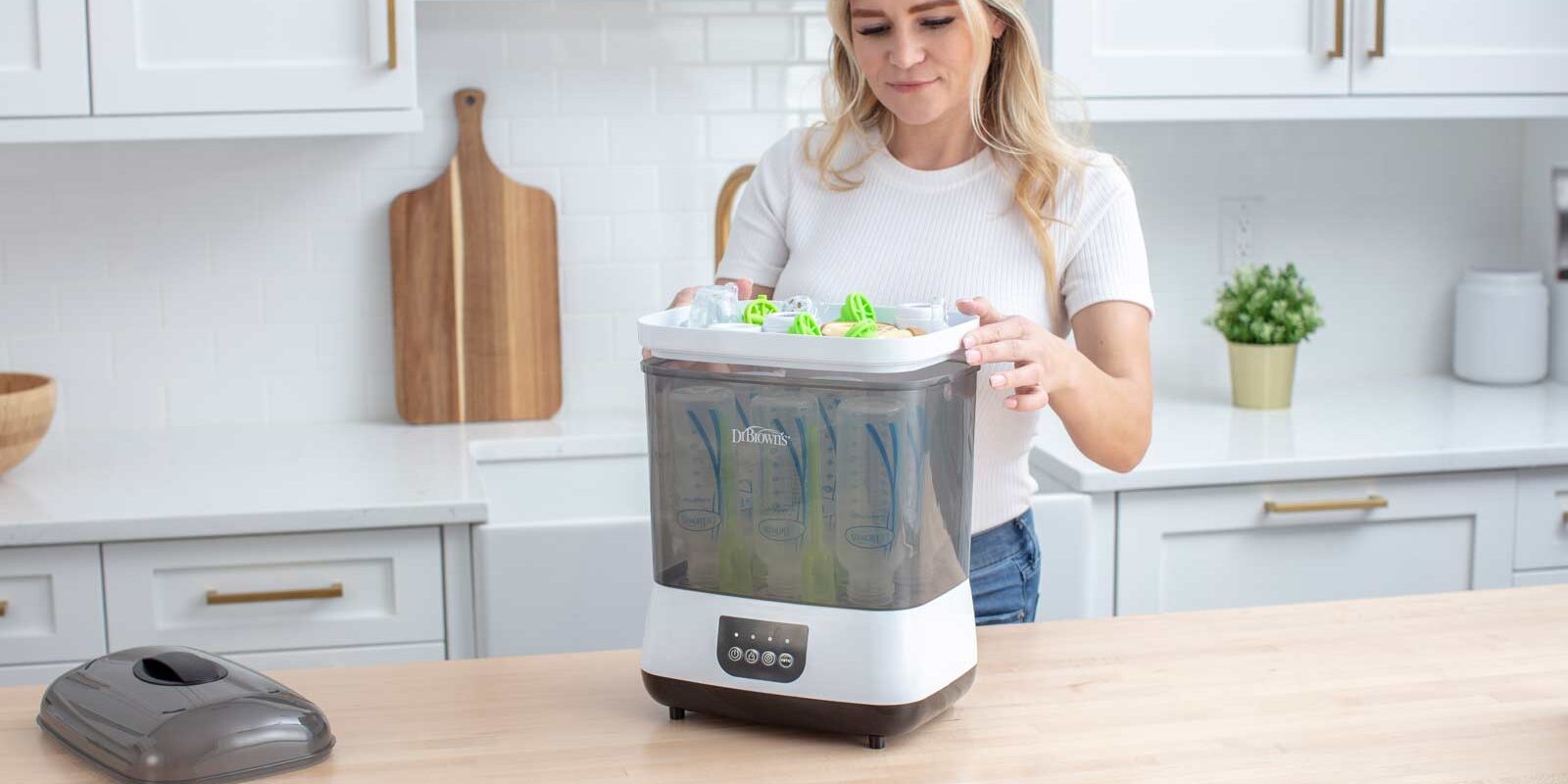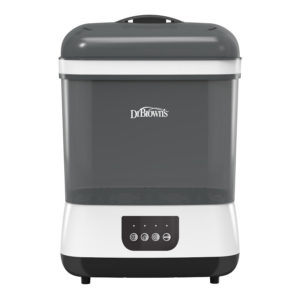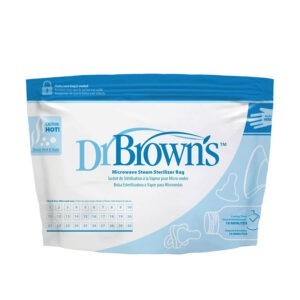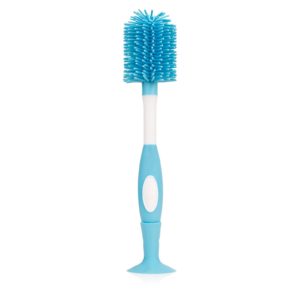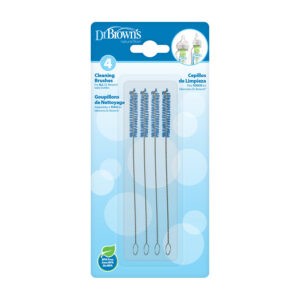Whether you are feeding your newborn pumped milk via a bottle or infant formula (or a combination of both), it’s important to know proper bottle preparation and other bottle hygiene guidelines to keep your baby safe and healthy. It can feel like a lot of information and directions at first, but from personal experience as both a pediatrician and parent, I can reassure you that you will get into a bottle-prep rhythm.
When is Bottle Sterilization Needed?
Sterilization of bottles is generally recommended only when you first obtain the bottles, and after major illness or thrush.
The exception is for babies born prematurely, those with weakened immune systems, or if directed by your child’s clinician. In those cases, it may be recommended to sterilize after every use.
To sterilize bottles, you can heat up a pot of water on the stove and let it boil. Separate all detachable parts of the bottle and place them in the boiling water for five minutes. Remove the items with a clean set of tongs and set to dry on a clean towel.
For a quick and convenient sterilizing option, this Bottle Sterilizer and Dryer from Dr. Brown’s is one of my favorite options. In a single cycle, it lets you both sterilize and dry up to six baby bottles, plus a mix of breast pump parts, pacifiers and teethers.
For on-the-go sterilizing needs—including taking to the hospital if you plan on bottle feeding from the beginning, or bringing along while traveling—you can try the Dr. Brown’s Microwave Steam Sterilizer Bags. If you have access to a microwave, you can sterilize those same baby bottles and parts in as little as 90 seconds.
What About Cleaning Bottles?
Though it’s generally unnecessary to frequently sterilize baby bottles, it’s imperative to properly clean them after every use. Ideally, you should clean each bottle as soon as possible after using it to avoid dried-on milk. Clean bottles with warm water, dish soap, and a bottle brush like this Soft-Touch Bottle Brush. Features like a no-slip grooved handle, ridged nipple cleaner, and the convenience of tossing it in the dishwasher or sterilizer make it an efficient and effective cleaning tool.
It’s really important to clean every part of the bottle, as milk can find its way into crevices and spoil over time. Using cleaning brushes like these, which are included with every Dr. Brown’s bottle purchase, can help get into those hard-to-reach places—like an internal vent system—that a larger bottle brush or sponge can’t reach. (Note: wire brushes are not recommended for cleaning bottle nipples.)
Save space on your counter by putting all bottle pieces on this Folding Drying Rack or a clean towel. This compact drying rack has a place for all bottle parts and folds for easy storage or travel. Remember to clean drying racks in the dishwasher every week to maintain optimal hygiene.
What are Best Practices for Preparing a Bottle?
Preparing a bottle for your baby isn’t difficult, but should be done correctly to avoid any health or safety issues.
When preparing a bottle of powdered formula, confirm with your child’s clinician if boiled water, tap water, or bottled water is fine. Most clinicians will recommend filtered tap water or bottled water that is kept at room temperature. If your baby is premature, they may recommend boiled water. You can feed ready-to-feed (liquid) formula directly from the baby bottle it comes in. Or, you can transport it to another bottle like the Dr. Brown’s Natural Flow Anti-Colic Options+ Narrow Bottle, which provides a more comfortable feeding experience for baby by decreasing spit-up, burping and gas.
Room-temperature formula is perfectly fine for babies. Some babies may prefer warm milk; in that case, you can use the Dr. Brown’s Deluxe Baby Bottle Warmer. If warmed, always check the temperature on your wrist before giving it to baby, and never heat in the microwave, as this can create hot spots that can scald little mouths.
Before making a bottle of formula, wash your hands with soap and water. Measure the desired amount of water into the baby bottle. This measurement will be on the back of the packaging of the formula container (for example, 1 scoop of formula per 2 fluid ounces of water). Make sure to always put the water in first and then add the recommended amount of formula.
Then, place the cap on the bottle and gently stir (with a clean spoon or stirrer) or swirl the bottle to blend the formula and milk together. Avoid shaking it, as that motion can cause air bubbles to form in the liquid. Continue blending until all major formula clumps have dissolved into the milk. (To quickly and easily make up to four 8-ounce bottles at once, try the Dr. Brown’s Natural Flow® Formula Mixing Pitcher.) Feed your baby formula within two hours of preparation. Throw out any formula that is left in the bottle after feeding your baby because the combination of formula and your baby’s saliva can cause bacteria to grow. Prepared but unused formula—as in the Formula Mixing Pitcher—can be stored in the fridge and must be used within 24 hours.
If making a bottle of pumped milk, you can pump directly into a bottle and feed immediately at room temperature. If you give pumped milk from the fridge, remove it from the fridge and place the sealed container into a bowl of warm water for a few minutes or safely and quickly warm breast milk to body temperature with the Dr. Brown’s Natural Flow® MilkSPA™ Breast Milk and Bottle Warmer. Test the temperature before feeding by putting a few drops on your wrist. Swirl the breast milk to mix fat content, which may have separated.
If you need to thaw frozen breast milk, always thaw the oldest breast milk first. You can either thaw it in the fridge overnight, place the sealed container in a bowl of warm water, or run it under warm water. Never warm breast milk in a microwave. If you thaw the milk in the fridge, use it within 24 hours. Once breast milk is brought to room temperature, use it within two hours. Never refreeze breast milk or place it back in the fridge if used.
Will I Find My Rhythm?
As you get into the groove of bottle feeding, cleaning and prep, you will learn a rhythm that works for you and your baby. Make sure to pull in any helpers, like partners, family members, and/or hired caretakers to properly sanitize and clean bottles when needed.
Happy (bottle) feeding!
About the author:
Dr. Mona Amin, Pediatrician.

Dr. Mona Amin is a Board Certified General Pediatrician, Parenting expert, and mother.
She has been featured on Parents.com, Romper, CondeNast Traveler, VeryWell Family, NBC News, and was named one of Insider’s Top Pediatricians to follow on social media for 2020. She works in private practice and her passions include: early childhood development, focusing on the impact of healthy sleep, a healthy relationship with food, and healthy coping skills in the first five years of a child’s life.
On her Instagram account (@pedsdoctalk), her podcast (The Pedsdoctalk Podcast), and YouTube channel (Pedsdoctalk TV), she shares educational information on parent’s most common concerns (i.e. fevers, rashes, viruses, behavioral issues, etc.) including current events. Her brand, Pedsdoctalk, has a goal to provide relatable and easy-to-digest education for the modern parent regarding the health and wellness of their child.
